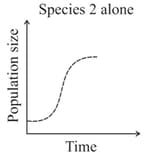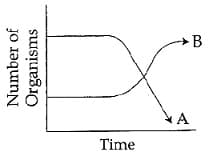EASY
Earn 100
A calf jumping when it sees mother cow, mother bird crying in distress when young ones are not found in the nest, a mother hen protecting its chicks either by covering them with wings or attacking the cat or eagle to protect the chicks-all these exhibit animal feelings. Think and list out the feelings of different organisms.
Important Questions on Basic Properties of Life
MEDIUM
Assertion (A): The Monarch butterfly feeds on poisonous weeds during its caterpillar stage.
Reason (R): It helps butterfly to become distasteful to the predator.
HARD
1) The human liver fluke, a nematode parasite, depends on two intermediate hosts (a snail and a fish) to complete its life cycle.
2) The malarial parasite needs a vector (mosquito) to spread to other host organisms.
3) In case of brood parasitism, the eggs of parasitic birds (e.g., cuckoo) are not detected and removed from the nest because the parasite's eggs resemble the host's eggs in morphology and colour.
4) A population of frogs protected from all predators would decrease indefinitely.
HARD
Given the graphs below, the interaction between species and can be classified as



EASY
Match the following?
| The list I | List II | ||
| (i) | Calotropis | (a) | Predator of Americana Pacific |
| (ii) | Cactus | (b) | Insects and frogs cryptically coloured |
| (iii) | Pisaster | (c) | Distasteful glycosides |
| (iv) | Monarch Butterfly | (d) | Cardiac glycosides |
| (v) | Camouflage | (e) | Predator is a moth |
MEDIUM

EASY
Relate Column I with Column II with regard to predatory behaviour
| Column-I | Column-I | ||
| Calotropis | p. | Invertebrates | |
| Pisaster | q. | Distasteful | |
| Monarch butterfly | r. | Cryptically coloured | |
| Frogs | s. | Cardioglycoside |
MEDIUM
If resources are limited
If two species occupy different niches
If resource partitioning takes place between two species
If two species occupy identical niche
EASY
EASY
MEDIUM

EASY
Match the following. The correct combinations are
| The list I | List II | List III | |||
| (a) | Fig tree | (i) | Highly distasteful | (p) | Petals of its flower |
| (b) | Ophrys | (ii) | Cryptically coloured | (q) | Special chemical present |
| (c) | Sea anemone | (iii) | Wasp | (r) | Clownfish |
| (d) | Camouflage | (iv) | Sexual deceit | (s) | Developing seeds |
| (e) | Monarch butterfly | (v) | Stinging cells | (t) | Insects and frogs |
EASY
MEDIUM
Study the following table and pick up the correct combinations.
| S.No | Type of parasite | Lives in host | Example |
| I) | Cytozoic parasites |
Live among cells of tissues of host |
Plasmodium |
| II) | Histozoic parasites | Live within the host's cells | Wuchereria |
| III) | Coelozoic parasites | Live in cavities of host | Ascaris |
| IV) | Hyperparasites | Lives in the body of another parasite | Nosema |
MEDIUM
Match column-I with column-II and select the correct option.
| Column-I | Column-II | ||
| a) | Commensalism | i) | Lichen |
| b) | Mutualism | ii) | Plasmodium |
| c) | Parasitism | iii) | Hawk |
| d) | Predation | iv) | Orchid |
MEDIUM
Match the items in Column with those in Column:
| Column | Column | ||
| (a) | Herbivores-Plants | (i) | Commensalism |
| (b) | Mycorrhiza-Plants | (ii) | Mutualism |
| (c) | Sheep-Cattle | (iii) | Predation |
| (d) | Orchid-Tree | (iv) | Competition |
Select the correct option from following:
MEDIUM
HARD
| Column-I | Column-II | ||
|---|---|---|---|
| Saprophyte | Symbiotic association of fungi with plant roots | ||
| Parasite | Decomposition of dead organic materials | ||
| Lichens | Living on living plants | ||
| Mycorrhiza | Symbiotic association of algae and fungi |
Choose the correct answer from the options given below:
EASY
HARD

